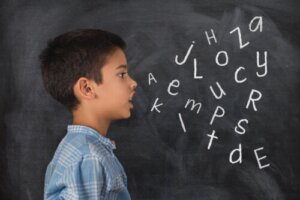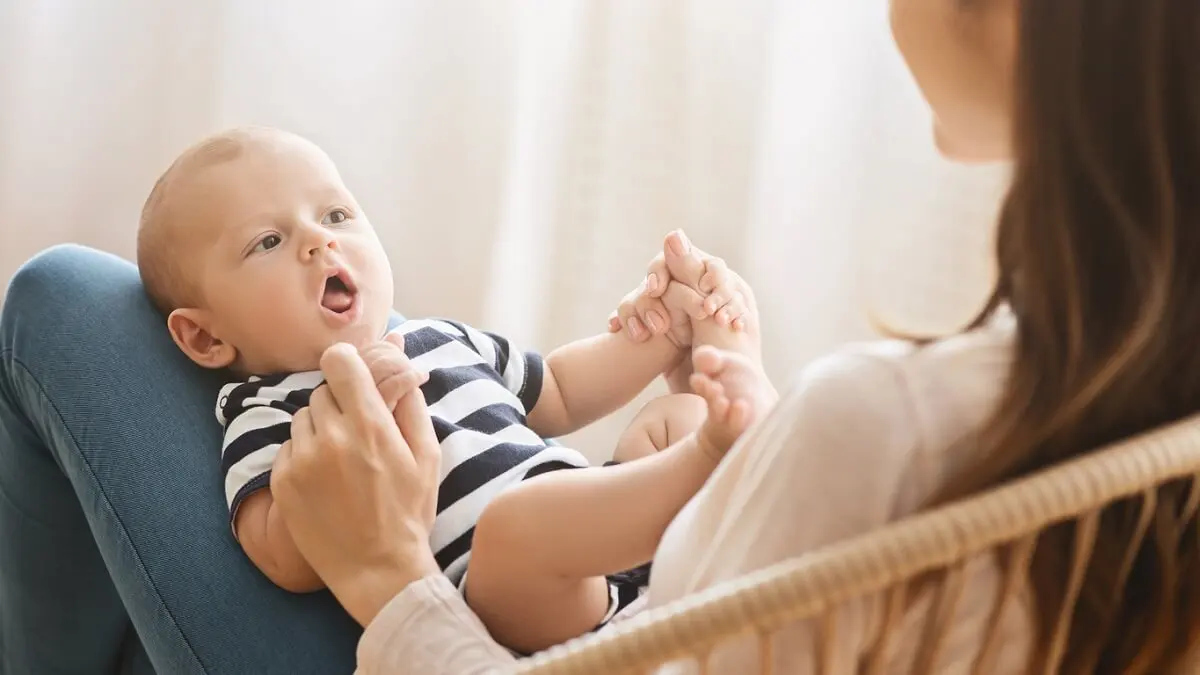Learn About the Stages of Language Development in Children

Language development in children happens progressively and cumulatively. This means that they learn little by little and acquire language skills gradually. This evolution occurs in more or less the same way and at the same age in everyone.
Through language, it’s possible to interact with other people and carry out general learning. Language development in children is much more intense during the first 3 years of life. Then it remains very active until the age of 7.
It doesn’t matter which language it is. In all cases, the maturation of the nervous system is necessary, as well as cognitive and socioemotional development to acquire language.
A child who is not exposed to language will not learn how to speak.
Language development
The baby begins to communicate with the world through crying. It learns that, through crying, it can get what it needs, whether it’s food, shelter, or companionship. Later, infants also learn to recognize their mother’s voice and the voices of people close to them.
As they grow older, infants learn to distinguish speech sounds. By 6 months, most of them recognize the basic sounds of their mother tongue. Gradually, they also develop the ability to speak.
During language development in children, there are a few critical stages. These are times when the child acquires specific communication skills. Monitoring allows parents and doctors to know if everything is progressing as expected or if there are any difficulties.
We think you may also enjoy reading this article: Emotional Communication: Tips to Better Connect and Express Yourself
The stages of language development in children
Language development in children occurs in 4 stages or phases:
- The prelinguistic phase
- The monohrasic phase
- The combination phase
- The advanced phase

1. The preverbal or prelinguistic stage
The first stage of language development in children is the preverbal or prelinguistic stage, which runs from the time of birth until the child is 1 year old. During this stage, 3 milestones are completed:
- From 0 to 3 months: The baby is sensitive to noise. He makes small sounds when spoken to and also gestures. Gurgles and cries appear, as well as some babbling.
- From 4 to 7 months: The baby shows readiness to make vocal sounds. He or she expresses moods through sounds such as laughter or complaints. The baby also calms down when hearing his or her parent’s voice. Attempts to say vowels and attention are much more focused.
- 8 to 12 months: The baby utters syllables with the intent to communicate. He or she understands the word “no” and responds to his/her own name. Attempts to communicate with gestures. The “laleo” or repetitive consonant and vowel sounds such as “paaa” emerge.
In this last stage, the so-called proimperatives also emerge. That is, the child points to what he or she wants and looks toward his or her goal. Also, prodeclarative expressions begin to appear, in which the baby transmits feelings through syllables or sounds.
2. The monophrasic phase
This stage in the development of language in children is characterized by the construction of sentences composed of a single word. Each term fulfills the function that will later be fulfilled by the sentence. The meaning of what they say depends on the context. For example, if they say “water,” it may mean “I want water.”
The infant also responds to simple questions with gestural language. If asked “where is the teddy bear?” he or she will point to where the toy is located. After 18 months, the child is able to ask for food by name, emit onomatopoeias (animals, cars), and have a vocabulary of about 50 words.
3. The combination phase
Around the age of 2 years, a new milestone in the development of language in children occurs. They are now able to combine words and, of course, meanings. In fact, they can now form meaningful sentences that include subject and predicate. The use of verbs appears.
This stage is known as telegraphic speech, as the child dispenses with several minor elements of language, such as connectors. By the age of 3, the child is also able to ask questions and construct exclamatory sentences with voice inflections.
We think you may be interesting in reading this, too: Body Language: 7 Tips for Increasing Your Confidence
4. Advanced language development in children
This phase completes language development in children in basic terms. It can begin as early as 16 months and goes up to age 4. At this point, toddlers’ speech closely resembles that of adults. However, they’re more capable of understanding language than producing it.
They have fun with language and laugh at absurdities. Two basic errors are characteristic of this stage:
- Overextensions: This occurs by using the same word to designate objects of the same genus. For example, they may use “dog” to talk about all animals.
- Underextensions: This is the opposite of the above. For example, he/she calls the dog at home “dog”, but does not use the same word for dogs he/she does not know.
The toddler is already able to make longer sentences, conjugate verbs in gerunds, and ask concrete questions. They can also refer to objects that are not present.
Therapies for language delay should be established by professionals who diagnose what the problem is.
What to do if something is wrong?
Language development in children may present some obstacles in specific cases. Sometimes, children are unable to understand what’s being said to them. Other times, they’re unable to express what they want. These difficulties are known as SLD or specific language disorders.
Also, the child may not be able to produce speech sounds correctly or may stutter. In these cases, the child may have a speech disorder.
In principle, you should first consult a pediatrician if you think your child may be having problems with their language development. The pediatrician may then refer the child to a speech therapist or a specialized therapist.
We’re not all the same
Language development in children is not the same for everyone. Some take a little longer and others evolve quickly. However, we all go through the same stages as described above.
If parents suspect that there’s some difficulty, it’s best to consult a pediatrician. The phrase “they’ll learn to talk eventually” is not a valid excuse. Instead, this could delay attention to a problem that has a better prognosis if detected early.
All cited sources were thoroughly reviewed by our team to ensure their quality, reliability, currency, and validity. The bibliography of this article was considered reliable and of academic or scientific accuracy.
- Fresneda, María Dolores, and Elvira Mendoza. “Trastorno específico del lenguaje: Concepto, clasificaciones y criterios de identificación.” Revista de neurología 41.1 (2005): 51-56.
- Font Banegas, J. Á. (2016). SEDILLABE: Sistema Experto de Ayuda al Diagnóstico del Llanto del Bebé.
- Yépez, M. E. N., García, E. B. B., García, R. I. D., & Quinteros, G. X. P. (2018). Modelo comunicacional para la etapa inicial de desarrollo del lenguaje en niños autistas. Revista Científica Retos de la Ciencia, 2(3), 35-46.
- Blanca, Laura González. “Trastorno específico del lenguaje (TEL): concepto y características.” Revista Internacional de apoyo a la inclusión, logopedia, sociedad y multiculturalidad 4.4 (2018).
- Cerdas Núñez, J., & Murillo Rojas, M. (2017). El desarrollo del lenguaje en los primeros cuatro años de vida: cómo favorecerlo desde la cotidianidad del espacio educativo. Revista Electrónica leer, escribir y descubrir, 1(2), 3.
This text is provided for informational purposes only and does not replace consultation with a professional. If in doubt, consult your specialist.








